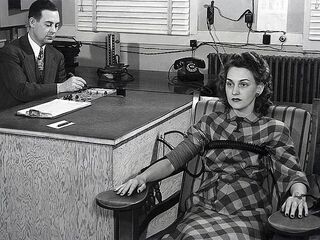Career
How Do Polygraphs Work?
A brief review of how lie detectors operate and how they are utilized.
Posted June 29, 2022 Reviewed by Kaja Perina
Key points
- When people lie, their bodies tend to react in detectable ways.
- Polygraphs measure physiological changes in the cardiovascular system, breathing, and sweating.
- By comparing the physiology of people when they are lying and telling the truth, lying can be detected.
- While polygraphs are fairly effective, there are still serious concerns about their reliability, validity, and accuracy.

The polygraph or lie detector test has been in use for over 100 years. It has been heralded as a technological marvel that allows investigators to accurately determine when someone is lying and when they are telling the truth. In a previous article, I summarized the findings on the accuracy of the polygraph. Here, I will provide a brief explanation of how the polygraph works.
Development of the Polygraph
Through the early 1920s, the polygraph was developed in a series of progressive additions and refinements by William Marston, John Larson, and Leonarde Keeler. In a single instrument, they brought together components that measure respiration, heart rate, blood pressure, and electrical conductivity in the skin (to measure sweating). The modern polygraph is now an integrated and computerized system.
How the Polygraph Operates
The polygraph rests on the principle that psychological states reliably lead to physiological changes in the body. More precisely, when people are lying, especially in the context of high-stakes criminal investigations or job interviews, they often experience fear, shame, anxiety, guilt, and worry.
Those emotional states then trigger physiological changes in the body that can be detected with the polygraph. The physiological changes are driven by the sympathetic nervous system in a process that is often referred to as the “fight or flight” response. When people detect a threat in their environment, their bodies prepare to deal with that threat by either confronting it or fleeing from it. The sympathetic nervous system activates the body to prepare it for action. The heart begins to race, blood pressure soars, breaths become deep and rapid, and the skin begins to perspire.
The fight or flight response activates when we are confronted with a threatening animal, when we narrowly avoid a crash on the highway, when we must speak before a crowd, or when we are worried about being caught in a lie. The polygraph detects those physiological alterations that occur when people lie, even if they are quite subtle.
Polygraph Procedures
If we measure someone’s physiological responses when they are being truthful and are presumably not worried or fearful, a baseline can be established. We can then know what that person’s blood pressure, heart rate, respiration rate, and sweating look like when they are being truthful. We can then compare that baseline response to the response they have when asked questions about which they might be lying.
A widely used polygraph procedure is called the control question test (CQT). The examinee is asked relevant questions (e.g., “Did you murder your wife?”) and they are also asked a series of control questions that are also likely to cause psychological turmoil and physiological responses (e.g., “Have you ever intentionally said harmful things to people close to you?”). The premise of the CQT procedure is that innocent people will have a stronger reaction to the control questions than the relevant questions, while guilty people will have stronger reactions to the relevant questions than the control questions.
Another polygraph technique is the Guilty Knowledge Test (GKT). The GKT procedure is premised on the idea that people will have a strong physiological response when confronted with information they know to be associated with a crime. For instance, if a person is accused of murdering their neighbor, the examiner might ask, “Was your neighbor killed with… a knife? …a gun? …poison? …a rope?” The idea is that the suspect will have a stronger physiological response to the actual murder weapon than to the incorrect ones, suggesting that the subject has special knowledge of the crime.
Limitations of the Polygraph
Though they have been consistently used in the United States and elsewhere for over a century, polygraphs are not without their critics. Criticisms of the polygraph tend to be on the grounds of reliability and validity. The reliability problem is that if the results of a polygraph examination are analyzed by multiple polygraph examiners, there are often disagreements, with some seeing evidence of deception, others seeing no evidence of deception, and others finding the results inconclusive.
The other major criticism is one of validity. That is, is the polygraph actually measuring deception? There is not any evidence that lying produces a distinct set of physiological reactions. People’s hearts can start racing for all manner of reasons. Likewise, some liars may have no discernible physiological reactions at all when questioned.
Lastly, there is ample evidence that polygraph accuracy normally falls below 90%. While 90% accuracy may seem impressive, an innocent person who is viewed as dishonest because of erroneous polygraph results may view things differently. The polygraph is an ingenious piece of modern machinery, but it is far from being a flawless lie detector.




